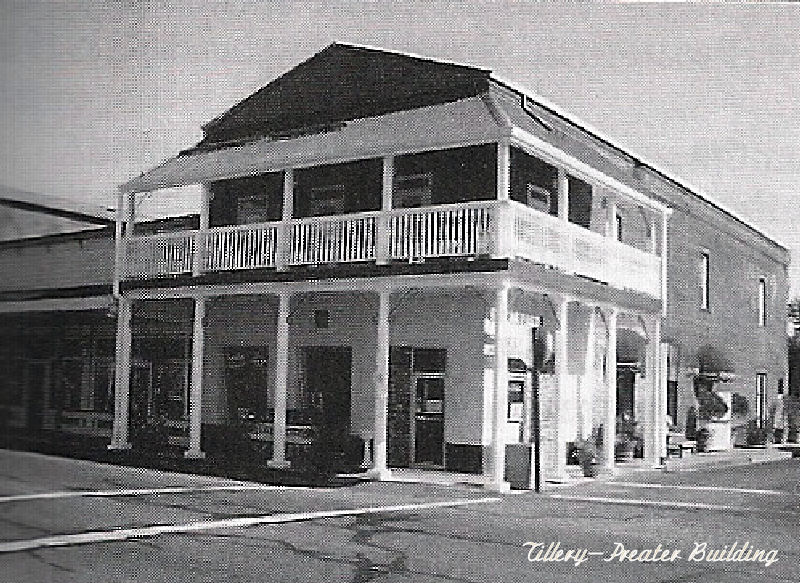





|
|
|
IONE AREA TOURS
CEMETERIES |
|
IONE AREA LODGING |
|
NEARBY LAKES |
|
|
Colburn's (Tillery=Preater Building, Ione - Amador County | ||
|
During a phone chat, I asked her if she knew how old the building was? Her guess circa 1900. Often one can't tell the age of many Main Street buildings because mod uglifications disguise their true age. But there's no false front on her building, variously called Colburn's, or Gillum's, Isaac' or Preater's, depending upon how far back you go in town history. Most of what you see has been there from its construction. If you know the county's architectural styles, you know - barring a superb restoration job - that the building is very old, older than even the city's vaunted United Methodist Community Church. Of course, Tilly's second floor porch, Victorian balustrade, Greek columns, and interior modernizing are new additions and touches. |
||
"Tilly's" brick building dominates the intersection of Main and Church. The comer was of the small village Thomas B. Rickey laid out in 1853 on his 160-acre land claim on both of Sutter Creek. Rickey's original "subdivision plat" filed with Calaveras officials, had just six village blocks. That corner lot, say 100 feet long and 60 feet wide, was first designated "Ll Block 2". |
|
|
|
Before pioneer merchant Daniel Stewart built Main Street's first brick store, that block in 1853 featured the "mother church" of the lone Methodist-Episcopal faithful. Church elders paid subdivider ( and trustee) Rickey $1,000 for the comer lot next to where Stewart would build.! From England sometime in the 1850s came Alfred and Thomas Prater (Preater), probably brothers. In 1856 Alfred became a citizen, and the county assessment book tells us he was a farmer near lone. Later, in 1860, the federal census found him still on the farm with wife Elizabeth. |
|
|
Certainly prosperous, Preater bought from the Thomas Rickeys in 1859 the barn and stable once connected to their Irene Hotel. And on September 26, 1862 the church trustees - Rickey, James H. Stevens, William C. Pratt, William Scudder and Henry sold to Preater and partner, F.P. Smith, for $800, half of the comer lot" and improvements". That seems expensive for a 90x30-foot lot with wooden church buildings. But would trustees have built a large, 2-story brick building anyway? While the deed was recorded in September, the transaction could easily have been agreed to earlier. Otherwise, how, by early October, 1862, could a 2-story brick building, fully 90 feet long and 30 wide, have risen on the former church property? |
|
|
|
As no county newspaper for 1862 exists, one looks in Sacramento, Stockton or San Francisco newspapers for gleanings about Amador. Such news appeared in the Sacramento Union following the 1st annual Amador Agricultural Fair, October 9 - 11, 1862, in lone! Where could they have staged such event, to house specimens displayed by 55 exhibitors? Of course, not Howard Park, although the first fair's race track and livestock barns were on that site or by the depot on Marlette. While the 2nd Amador fair in 1863 was held in the incomplete Methodist Church, that Gothic edifice wasn't nearly ready in '62. No, the first fair in county history was held in "the large hall of Preater & Smith .... !" Said the Union: "The fruit etc. began arriving in the hall the evening of the 8th ... Further, "the hall was well-filled and illuminated" the first night, crowded the entire second day, and at 5 p.m. closing day, cleared for a ball! Surely, Preater and Smith's new brick, 2- story hall had just been recently completed. Was the fair its first user? Or were businesses on the ground level, and the fair held upstairs? We don't know? But there is little doubt that the 1862 Preater and Smith Hall is Tilly's restaurant building today, much older than she knew or imagined. The building's architecture also is evidence of an early 1860s construction, the modern Victorian trim not withstanding. Expert masons could study the brickwork and judge when such style was used. But the tell-tale evidence is (or are) the windows and doors. Brick buildings in Amador built in the 1850s almost invariably had rectangular door and window openings. Observe the county museum, built in 1859. But in the 1860s, however, another style competed with Greek rectangles - Roman arches. Bet that any window or door with at top a curved course of brick (or wood, for that matter: i.e, St. Patrick's Church in Jackson) betrays construction in the 1860s or later. Those slightly curved courses above Tilly's doors and windows also tell me that it was built early in the 1860s. Not long after the 1862 fair, church trustees sold the rest of Lot 1 on Main Street and Lot 6 behind the big building to Preater for $2,500. It may have included the pioneer church and even parsonage. That same year, Preater reached agreement with the claimants to the Arroyo Seco Grant, and paid them another $800 for all the property he already paid others for! Also, during those years other transactions were recorded related to the rest of the original church property not utilized in 1862 by Preater and Smith for their magnificent hall. Those we need not consider here. In time, the large, brick building would be owned by two Prussian immigrants, naturalized citizens in Amador in the 1850s. Historians know them as Bernhard and Michael Isaacs. They owned the building longer than anyone. Other than the site of the Wooster and Reed sawmill - set up in 1851 near Sutter Creek's flow at the end of today's lone Street - there's probably no more historic spot in lone than the corner of Main and Church where Loretta Tillery's balconied dining room and coffee shop stands. After Thomas Rickey subdivided some of his 160-acre claim for a town site in 1853, the Methodist-Episcopal Church bought one third of a block, or a lot 662/3 feet on Main and 200 feet on what is now Church. On that corner rose their church in front, where Tilly's brick building is, and a parsonage in back. Though the lane from Main had many churches on or near it in the early days, its name definitely comes from the M. E. church that arose at its foot in '53. Preater and Smith's hall, the exhibitor's hall in 1862 for the 1st Amador Agricultural Association Fair, probably went up some time that year and it has stood there ever since. Why the review? To solidify my own conclusions and perhaps clear up any confusion in yours. That unheralded hall has been around for a long time, and Tilly has given it new life and new uses. When the writer arrived in 1964, that corner building was Colburn's drug, one of at least two owned by the druggist-politician-supervisor, Harold E. Colburn, and his wife, Marie. Later, after "meeting" historic lone personages like the druggist Perkins, one assumed tha Colburn's historically had been the drug store corner. But those who have grown up here know better, and hence the prudent course is to be silent about recent history. Incidentally. many Colburn kin reside in the county. If not drug store, what? Historically, it appears that the corner, after the church, was a general store, with a short list of owners, until 1959. In one of those odd coincidences, associate and friend, Allen Martin, inventorying the issues of Ione Progress-News for 1959, happened upon the October 29 issue announcing that Gillum's store, which operated in this building, was going to donate to the county museum a letter cabinet and mail box which Railway Express agent Lester Gillum had probably used since family took over store in the 1920's. As written in "Logan's Alley" Vol V. (There are more writings yet) |
||
Return to our Ione Tour or click on our Miner to end the tour 
|
||
|
Information, photographs courtesy of the Amador County Archives, The Historical Marker Database, The Chronicling America Database, and Larry Cenotto, Amador County's Historian CONTACT US
|
||


